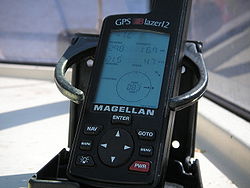
Back إشارات جي بي إس Arabic Rádiové signály GPS Czech GPS-Technik German سیگنالهای جیپیاس Persian אותות GPS HE GPS信号 Japanese GPS-signaler Swedish GPS-сигнали Ukrainian GPS信号 Chinese


| Geodesy |
|---|
 |
GPS signals are broadcast by Global Positioning System satellites to enable satellite navigation. Using these signals, receivers on or near the Earth's surface can determine their Position, Velocity and Time (PVT). The GPS satellite constellation is operated by the 2nd Space Operations Squadron (2SOPS) of Space Delta 8, United States Space Force.
GPS signals include ranging signals, which are used to measure the distance to the satellite, and navigation messages. The navigation messages include ephemeris data which are used both in trilateration to calculate the position of each satellite in orbit and also to provide information about the time and status of the entire satellite constellation, called the almanac.
There are four GPS signal specifications designed for civilian use. In order of date of introduction, these are: L1 C/A, L2C, L5 and L1C.[1] L1 C/A is also called the legacy signal and is broadcast by all currently operational satellites. L2C, L5 and L1C are modernized signals and are only broadcast by newer satellites (or not yet at all). Furthermore, as of January 2021[update], none of these three signals are yet considered to be fully operational for civilian use. In addition to the four aforementioned signals, there are restricted signals with published frequencies and chip rates, but the signals use encrypted coding, restricting use to authorized parties. Some limited use of restricted signals can still be made by civilians without decryption; this is called codeless and semi-codeless access, and this is officially supported.[2][3]
The interface to the User Segment (GPS receivers) is described in the Interface Control Documents (ICD). The format of civilian signals is described in the Interface Specification (IS) which is a subset of the ICD.
© MMXXIII Rich X Search. We shall prevail. All rights reserved. Rich X Search